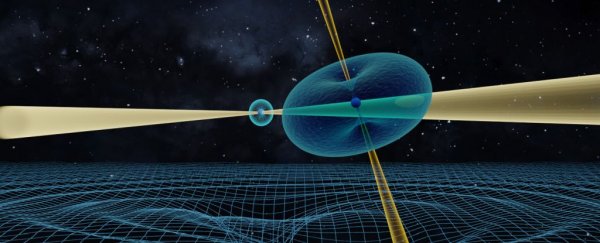Two pulsars locked in close binary orbit have once again validated predictions made by Einstein's theory of general relativity.
Over 16 years, an international team of astronomers has observed the pulsar pair, named PSR J0737−3039A/B, finding that the relativistic effects can be measured in the timing of their pulses – just as predicted and expected. This is the first time these effects have been observed.
"We studied a system of compact stars that is an unrivalled laboratory to test gravity theories in the presence of very strong gravitational fields," says astronomer and astrophysicist Michael Kramer from the Max Planck Institute for Radio Astronomy in Germany, who led the research.
"To our delight we were able to test a cornerstone of Einstein's theory, the energy carried by gravitational waves, with a precision that is 25 times better than with the Nobel-Prize winning Hulse-Taylor pulsar, and 1,000 times better than currently possible with gravitational wave detectors."
Pulsars are arguably the most useful stars in the sky. They are a type of neutron star, which means they are very small and dense; up to 20 kilometers (12 miles) across, and up to around 2.4 times the mass of the Sun.
What makes them pulsars is the fact that, well, they pulse. They have beams of radiation in radio wavelengths shooting from their poles, and are oriented in such a way that these beams flash like a lighthouse beam as the star rotates, at up to millisecond speeds.
These flashes are incredibly precisely timed, which means that to us, pulsars are possibly the most useful stars in the Universe. Variations in their timing can be utilized for navigation, for probing the interstellar medium, and for studying gravity.
PSR J0737−3039A/B, discovered in 2003, located around 2,400 light-years away, and the only double pulsar identified to date, presented a new opportunity for study: another test of relativity, in what the researchers called an "unrivalled laboratory" for testing gravity theories.
The two pulsars are very close together, completing an orbit every 147 minutes. One rotates quite fast at 44 times per second. The other is younger and slower, rotating once every 2.8 seconds. But because these objects are so dense, their gravitational fields are very strong, which means they can affect the timing and angle of each other's pulses.
Using seven powerful telescopes around the world, over the course of 16 years, this is what the researchers looked for.
"We follow the propagation of radio photons emitted from a cosmic lighthouse, a pulsar, and track their motion in the strong gravitational field of a companion pulsar," says astrophysicist Ingrid Stairs of the University of British Columbia in Canada.
"We see for the first time how the light is not only delayed due to a strong curvature of spacetime around the companion, but also that the light is deflected by a small angle of 0.04 degrees that we can detect. Never before has such an experiment been conducted at such a high spacetime curvature."
In total, the researchers performed seven tests of general relativity, including the way the orientation of the binary's orbit changes, known as apsidal precession, and the way the pulsars drag space-time around with them as they spin, called frame-dragging or the Lense-Thirring effect. This allowed precision tracking of the pulsar timing.
"Apart from gravitational waves and light propagation, our precision allows us also to measure the effect of "time dilation" that makes clocks run slower in gravitational fields," explains astrophysicist Dick Manchester from CSIRO in Australia.
"We even need to take Einstein's famous equation E = mc2 into account when considering the effect of the electromagnetic radiation emitted by the fast-spinning pulsar on the orbital motion. This radiation corresponds to a mass loss of 8 million tonnes per second! While this seems a lot, it is only a tiny fraction – three parts in a thousand billion billion – of the mass of the pulsar per second."
The results join a growing body of high precision measurements of relativistic effects that all, so far, agree with Einstein's predictions. The space-time around supermassive black hole M87*, the way stars orbit the Milky Way's own central supermassive black hole, the timing of atomic clocks, a triple-star system and 14 years' worth of observations of a wobbly pulsar – all are consistent with general relativity.
Over the next few years, as more powerful telescopes emerge, we are likely to see even more precise tests of gravity under general relativity, as scientists continue to look for holes.
"General relativity is not compatible with the other fundamental forces, described by quantum mechanics. It is therefore important to continue to place the most stringent tests upon general relativity as possible, to discover how and when the theory breaks down," explains astrophysicist Robert Ferdman of the University of East Anglia in the UK.
"Finding any deviation from general relativity would constitute a major discovery that would open a window on new physics beyond our current theoretical understanding of the Universe. And it may help us toward eventually discovering a unified theory of the fundamental forces of nature."
The research has been published in Physical Review X.
